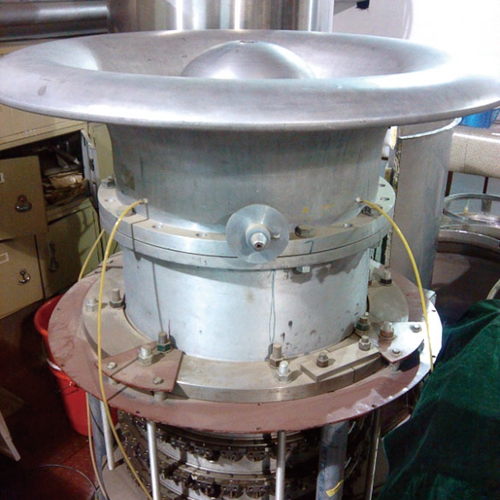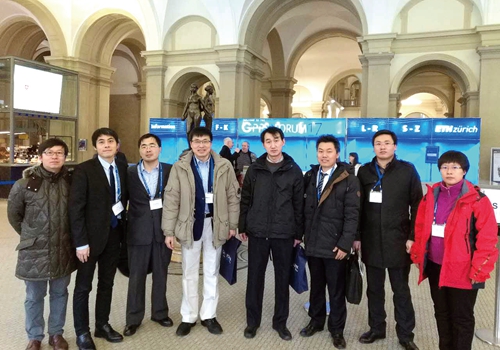Research Fields
Fundamental research of gas turbine, Research and development of key technologies, and Engine system integration.
1. Design and optimization of Gas turbine overall performance and engine structure
2. Design of multi-stage axial compressor with high pressure ratio and high efficiency
3. Low-emission fuel-flexible gas turbine combustor design
4. Turbine aerodynamic and blade cooling design
5. Gas turbine control system development
Scientific Research Instruments and Equipment
1.Horizontal Three-stage Axial Flow Compressor
The three-stage axial flow compressor is driven by D.C motor with 18.5kW. The design rotational speed is 3000 rpm, the number of both rotor blades and stator blades is 60. The blade is designed to model a modern high-pressure compressor. The opening of the outlet throttle can be adjustable.
2.Vertical Three-stage Axial Flow Compressor
The compressor is driven by a motor of 55-kW power and the rotor speed is controlled by a frequency converter. The opening of throttle valve used to regulate the flow rate is controlled by a stepping motor which assures fast exit from stall. The stagger angle of IGV and stator blade is adjusted by the stepping motor. An NJ-type torque-speed transducer installed between the compressor and the driving motor is used to measure the torque and rotor speed of the compressor combined with the NC-2A type torque measuring instrument.
3. Vertical Large Scale Low Speed Multi-stage Axial flow Compressor
The test rig is the first vertical large scale low speed axial flow compressor test rig in China. The vibration and noise has been well controlled during the operation. The main parameters of the test rig are listed as follow: Outer diameter is 1.3 meter, design speed is 1000rev/min and design mass flow rate is 11 kg/s. The rotor hub and casing are both divided into three parts and are designed to hold three stages with IGV at inlet. Transparent casings, made of organic glass, have been prepared for PIV\LDA together with other visualization measurement method to gain detailed information about the tip region flow field, which contribute greatly to flow stability and efficiency.
4. The Static Calibration Device of Plasma Measuring Instrument
The experimental test rig contains pump, chamber, source, valve, etc. When doing the calibrating experiments, the sensor is put in the center of a chamber. Then, the pump pumps the air out. The barometer measures the gas pressure. The electrical measurement was used to diagnose the discharge. Rt is a current-limited resistance with a value of 100 kΩ-500 kΩ to prevent the electrode overheats. Rt is concatenated between the glow anode and high-voltage contactor. The discharge current is measured with a current-monitoring non-inductive resistor Ri of 509Ω concatenated between the glow cathode and ground contactor. A direct voltage from a power source was applied to the electrodes. The output from the plasma sensor was measured by a Tektronix 1000:1 high-voltage high-bandwidth probe. A digital storage oscilloscope, DPO3012 from Tektronix is used to record the voltage across the electrodes and the voltage across the current sampling resistance.
5. Scaled turbine cooling test rig
The Scaled turbine cooling test rig is an open-cycle, low-speed continuously tunnel rig. The mainstream is provided by a 55kW radial-flow blower. The max pressure head of the blower is up to 8,515Pa and the maximum mass flow rate is up to 4.5kg/s. After the blower are the transition section, settling section, contraction section and test section of linear cascade. The mainstream is accelerated in the contraction section to 15m/s, with a turbulence intensity of 3.5%.Four printed resin vanes are placed in the test section. The coolant is provided by the film-cooling injection system, which is composed of an air compressor, air reservoir, electromagnetic flowmeters and valves. Probe slot is placed downstream the vane trailing edge for the total pressure measurement. Total pressure measurements are carried out at the location of probe slot, using a five-hole probe fixed on an automatic shifting axes frame. The control and acquisition system are constructed on NI PXI platform.
6. Advanced Combustor and Flame Test Rig
The combustion and flame test rig is composed of several subsystems, including air supply, fuel supply, measurement and control, heat exchange, and cooling water subsystems. The maximum air pressure can reach up to 0.8MPa, while the maximum air flow rate up to 0.5kg/s. Multiple fuels can be supplied, such as CH4, CO, H2, syngas, hydrogen rich fuel and low-btu fuel. The combustor inlet airflow can be heated up to 350℃ by the hot exhausted gas through the heat exchange subsystem.
Major Achievements in 2016
1.Research in compressor: Finished the experimental works of self-recirculating injection in multi-stage axial flow compressor, and the stall margin improvement of 13% was obtained with no efficiency penalty. Finished the design of multi-stage axial flow compressor in an industrial gas turbine.
2. In the respect of combustion research, experimental studies of the combustion characteristics of hydrogen-rich fuel in a lean premixed model gas turbine combustor were investigated. Based on the experimental data, the design method of lean premixed combustor for hydrogen-rich fuel has been developed. The design of a ring combustor for an industrial gas turbine has been finished.
3. Research in turbine: Developed a heat transfer computation program for turbine vanes and blades with film cooling and TBC (Thermal Barrier Coating), based on CHT (Conjugate Heat Transfer) method. Finished the design and full temperature film-cooling efficiency experiments for the first stage guide vane of an F-class gas turbine. Completed the high pressure turbine design of an industrial gas turbine.
Team Building
The laboratory has 23 faculty members, including 3 professors, 6 associate professors, 3 postdocotors. The number of master and Ph.D students is 12. The number of staff employed under contract is 2, including 1 associate professor.
In 2016, 3 new master students enrolled, 2 master students were approved to pursue their doctoral degree, 3 Ph.D students and 5 master students graduated.
Prof. Zhang Hongwu and Prof. Nie Chaoqun were appointed as the members of Academic Committee of Institute of Engineering Thermophysics, Chinese Academy of Sciences. Prof. Liu Jianjun was appointed as the committee member of Turbomachinery Division, Chinese Society of Aerospace Power, Chinese Society of Aeronautics and Astronautics. Meanwhile, Prof. Liu Jianjun was a council member of Beijing Association of Thermophysics and Energy Engineering.
Technology Transfer
Based on the "strategic cooperation agreement" signed by Hefei City People's government and the Institute of Engineering Thermal physics, Chinese Academy of Science, The CAS Hefei Industrial Gas Turbine Research Institute Co., Ltd. was established in September 28, 2016 in Chaohu of Hefei city. The registered capital is CNY 250 million. The company is engaged in research and development of industrial gas turbine and its industrialization. The company has completed the pre-construction and gas generator prototype procurement work, and actively promoted R & D and industrialization.
Patents and Paper
4 Chinese invention patents have been authorized. Published 24 research papers, and 20 are indexed by SCI/EI.
Title: Performance of a gas cooled molten salt heat exchanger.
Author: Qian Jin, Kong Qiaoling, Zhang Hongwu
IF: 3.043
An experimental system has been built to research the heat transfer characteristics of gas cooled molten salt heat exchangers. Based on the system, a prototype tube-and-shell gas cooled molten salt heat exchanger was experimentally investigated. A nitrate salt mixture (NaNO3-KNO3-NaNO2) was chosenas the hot fluid in the tube side. Helium and air were chosen as the gas fluids in the shell side, respectively. A modified Wilson plot method was used to separate the heat coefficients in both sides.
Convective heat transfer data of molten salt in tube bundles are obtained within the range of Re from 4138 to 11191 and Pr from 9.8 to 18.9. It is compared with two empirical correlations: Gnielinskito Equation and Hausenon Equation. Comparison of the heat transfer characteristics between air and helium in the shell side is also discussed. A detailed thermal resistance analysis inside the heat exchanger is made and the way to improve its thermal performance is clarified.
Awards
Liu Jianjun serves as member of The ASME turbo machinery professional committee;
Fu Jinglun is review expert of the Journal Proceedings of the Institution of Mechanical Engineers.
International Cooperation and Exchanges
1. Du Juan, Associate Researcher, from 2015/3 to 2016/8 in Leibniz Universität Hannover with the Alexander von Humbold Research Fellowship supported by Alexander von Humboldt Foundation in German.
2. Geng Shaojuan, Associate Researcher, in 2015 went to ÉcolePoly technique de Montréal in Canada to work for a year as a visiting scholar.
3. Fu Jinglun, Associate Researcher, in 2016 went to University of Central Florida in USA to work for a year as a visiting scholar.
4. Nan Xi, Assistant Researcher, in 2016 went to University of Tokyo in Japan to work for a year as a visiting scholar.
Dean: Zhang Hongwu Tel: 86-10-82543075 E-mail: zhw@iet.cn
Deputy Dean: Liu Jianjun Tel: 86-10-82543060 E-mail: jjl@iet.cn

Scaled turbine cooling test rig

Horizontal Three-stage Axial Flow Compressor

Vertical Large Scale Low Speed Multi-stage Axial flow Compressor

Vertical Three-stage Axial Flow Compressor

The Static Calibration Device of Plasma Measuring Instrument

Researchers participate the first Global Dynamics and Advocacy Forum